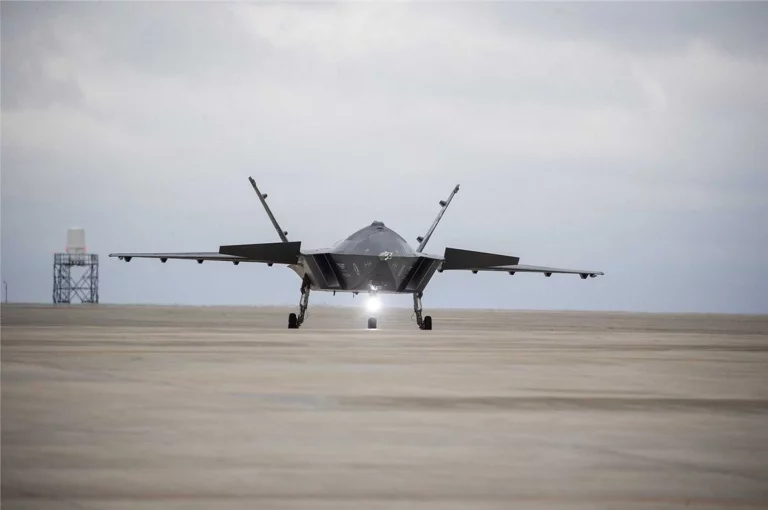In a groundbreaking development for Türkiye’s defense capabilities, the Bayraktar KIZILELMA unmanned fighter jet is set to join the Turkish Navy’s carrier fleet by 2026. This next-generation unmanned combat aerial vehicle (UCAV), developed by Baykar, a leading Turkish drone manufacturer, marks a major advancement in unmanned systems. Baykar, already renowned for its Bayraktar TB2 and Akıncı drones, has crafted the KIZILELMA with advanced autonomy, stealth capabilities, and multi-role versatility, positioning it to reshape the future of aerial warfare.
On May 5, 2025, Haluk Görgün, President of the Presidency of Turkish Defense Industries (SSB), shared key updates on this ambitious project, emphasizing its transformative potential for Türkiye’s defense and aerospace independence.
The KIZILELMA project kicked off in 2021, entirely self-funded by Baykar, reflecting the company’s dedication to innovation and self-reliance. Building on the proven success of its earlier drones, Baykar has moved swiftly with the KIZILELMA’s development. The third prototype, known as TC-ÖZB3, took to the skies for its first flight on December 14, 2022, just over a year after the project began. Since that milestone, the aircraft has faced extensive testing, including the Aerodynamic System Identification Test in March 2025, which verified its core design elements and confirmed the reliability of its avionics and flight control systems.
Baykar sees the KIZILELMA as far more than a typical drone—it’s a combat aircraft built for a future where unmanned systems play a dominant role alongside manned fighters. The company has stated that this UCAV, developed fully within Türkiye, will take on an increasingly vital role as air combat evolves. This vision dovetails with Türkiye’s broader ambition to lessen its dependence on foreign technology and strengthen its own capabilities across all defense sectors. By keeping the KIZILELMA’s development in-house, Baykar is helping pave the way for Türkiye to stand as a leader in unmanned aerial technology.
The KIZILELMA brings a rare mix of stealth, agility, and operational flexibility to the table, setting it apart in the global UAV landscape. With a maximum take-off weight of 8.5 tons and a payload capacity of 1.5 tons, it can haul a variety of equipment and munitions tailored for strike and reconnaissance missions. A turbofan engine powers the aircraft, enabling fully autonomous operations—everything from takeoff and landing to taxiing and cruising. This autonomy broadens its usefulness across different combat environments, making it a highly adaptable platform.
When it comes to flight performance, the KIZILELMA strikes an effective balance between speed and endurance. It cruises at 0.6 Mach and can push up to a maximum speed of 0.9 Mach, giving it the flexibility to handle diverse mission profiles. Its combat radius stretches to 500 nautical miles, or roughly 926 kilometers, while its service ceiling reaches 45,000 feet (about 13,700 meters) and its operational altitude sits at 25,000 feet (around 7,620 meters). These numbers mean it can fly above most short-range air defenses and hold its own in contested airspace, offering Türkiye a clear edge in modern conflicts.
The aircraft’s endurance tops three hours, letting it stay aloft for extended missions without constant ground support. Its communication setup includes both Line-of-Sight (LOS) and Beyond-Line-of-Sight (BLOS) modes, ensuring steady links with operators no matter the distance or conditions. This dual-mode system keeps the KIZILELMA responsive and effective, whether it’s engaging targets up close or operating far from base.
Onboard, the KIZILELMA carries an impressive array of sensors, including an electro-optical targeting system, an infrared search and track (IRST) system, and a multi-mode AESA radar. These tools allow it to spot, follow, and strike targets with pinpoint accuracy, making it a threat in both air-to-air and air-to-ground scenarios. Its arsenal includes laser-guided bombs, air-to-surface missiles, and long-range cruise missiles, most of which tuck away inside the aircraft to keep its stealth profile intact. This internal weapon storage helps maintain a low radar cross-section (RCS), a critical advantage over many other UCAVs.
Physically, the KIZILELMA measures 14.5 meters long, with a 10-meter wingspan and a 3.5-meter height. Its stealth-focused design, paired with high maneuverability, gives it the nimbleness to thrive in hostile skies. One standout feature is its ability to take off and land on short-runway aircraft carriers like the TCG Anadolu. This lets Türkiye extend its unmanned airpower to the seas, a capability only a few nations have mastered. This carrier compatibility boosts the country’s strategic reach and operational options considerably.
The KIZILELMA’s development ties into Türkiye’s larger push to climb the ranks of the global defense market. The TB2 and Akıncı drones have already shown their worth in conflicts worldwide, cementing Baykar’s reputation as a top UAV exporter. Adding the KIZILELMA to the lineup is expected to reinforce Türkiye’s status as a go-to source for cutting-edge drone technology. As it nears full operational status in 2026, the aircraft signals a new chapter for both Baykar and the future of unmanned airpower, showcasing Türkiye’s drive for innovation and independence in defense.
In wrapping up, the Bayraktar KIZILELMA unmanned fighter jet stands as a game-changer in aerial technology and a major boost to Türkiye’s defense strength. With its stealth, autonomy, and ability to operate from carriers, it’s ready to reshape how air combat unfolds. Set to join the Turkish Navy’s carrier fleet by 2026, the KIZILELMA reflects Türkiye’s forward-thinking strategy and its rising clout in the global defense scene.
